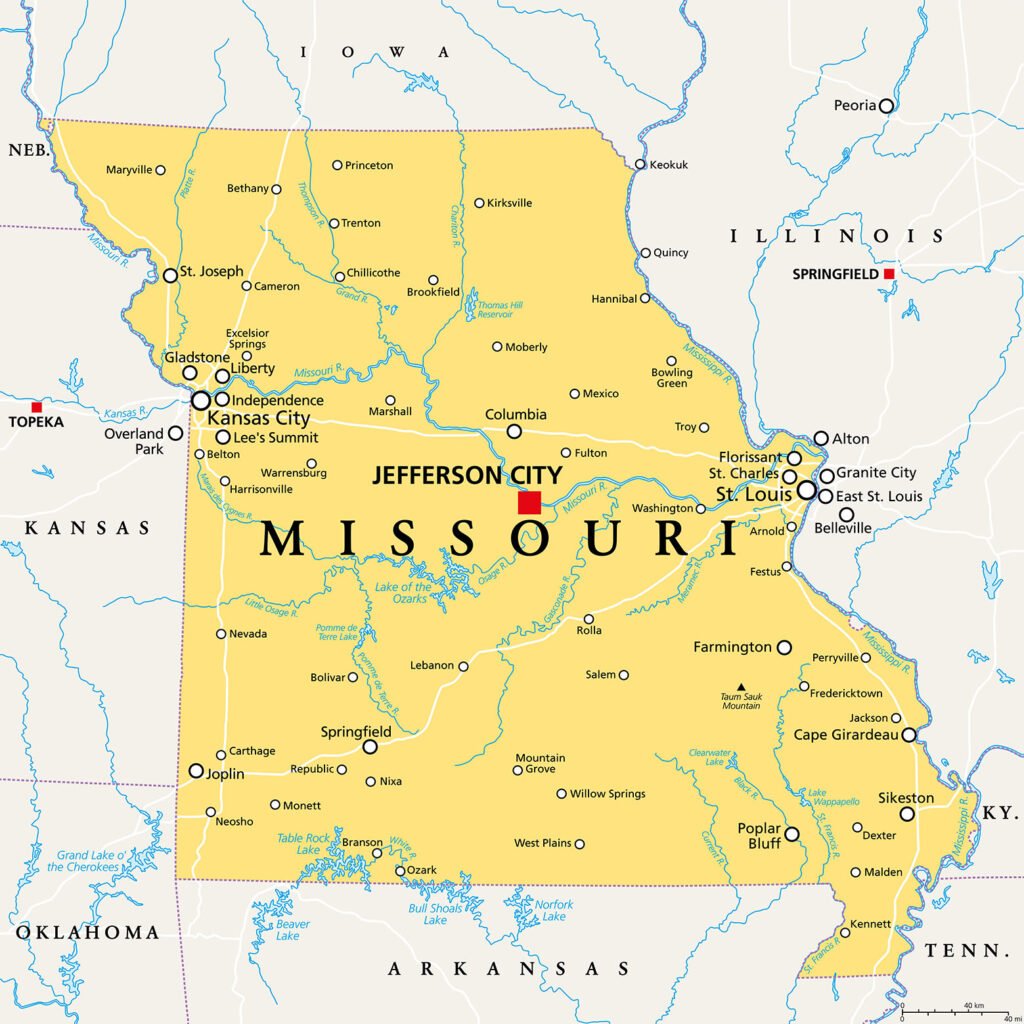About the State of Missouri
Located in the heart of the United States, Missouri is a state that bridges the Midwest and the Southern regions, offering a diverse blend of cultural, historical, and natural attractions.
The state’s two major rivers, the mighty Mississippi and the Missouri, define much of its eastern and western boundaries, respectively. The confluence of these rivers near St. Louis not only shapes the state’s geography but also its historical and economic significance. The Mississippi River is one of the longest rivers in the world, flowing all the way from Minnesota to the Gulf of Mexico, while the Missouri River is the longest river in North America, snaking its way through the western part of the state.
Missouri’s major cities, St. Louis and Kansas City, play a pivotal role in its economy and cultural landscape. St. Louis, located along the Mississippi River, is known for its iconic Gateway Arch, which symbolizes the westward expansion of the United States. Kansas City, positioned on the border with Kansas, is renowned for its vibrant arts scene, including jazz and blues music, as well as its famous barbecue cuisine. Other significant cities include Springfield, which acts as a gateway to the Ozarks, and Columbia, home to the prestigious University of Missouri.
Quick facts
Missouri By The Numbers
6,160,281
Population (2020)
69,715
Area (square miles)
1821
Year of Statehood
Missouri

A Brief History of Missouri
Economic Overview of Missouri
Missouri’s Diverse Climate
Tourism and Cultural Attractions
Missouri’s tourism industry thrives on an impressive array of cultural attractions and natural landscapes, making it a cornerstone of the state’s economy. The Gateway Arch in St. Louis stands as a monumental symbol, drawing countless visitors to experience its architectural grandeur and panoramic views of the city. Adjacent to the Arch, the Museum at the Gateway Arch delves into the rich history of westward expansion, providing a deep sense of the state’s historical significance.
Branson, often referred to as the “Live Entertainment Capital,” showcases Missouri’s vibrant entertainment scene. Nestled in the Ozark Mountains, Branson hosts a plethora of live shows ranging from country music concerts to theatrical performances, ensuring a captivating experience for all visitors. The city’s Silver Dollar City, a renowned 1880s-style theme park, further enhances the tourist experience with its thrilling rides, craft demonstrations, and family-friendly events.
Kansas City plays a pivotal role in Missouri’s cultural landscape, particularly through its contributions to jazz and barbecue. The American Jazz Museum and the Negro Leagues Baseball Museum, both located in the historic 18th & Vine Jazz District, highlight Kansas City’s impact on American history and culture. Additionally, the Nelson-Atkins Museum of Art, with its extensive collection spanning various time periods and cultures, stands as a testament to the city’s artistic relevance.
Missouri’s national parks and natural attractions offer outdoor enthusiasts a plethora of activities. The Ozark National Scenic Riverways and the Mark Twain National Forest provide opportunities for hiking, fishing, and exploring lush landscapes that captivate nature lovers. For those interested in geological wonders, the ancient Meramec Caverns present a stunning display of subterranean beauty.
Moreover, Missouri boasts numerous historical landmarks that offer deep insights into America’s past. The Harry S. Truman Presidential Library and Museum in Independence pays homage to the 33rd president of the United States, while Wilson’s Creek National Battlefield commemorates an important Civil War site. These destinations collectively enrich Missouri’s cultural and historical tapestry, making it a must-visit state for any passionate traveler.
